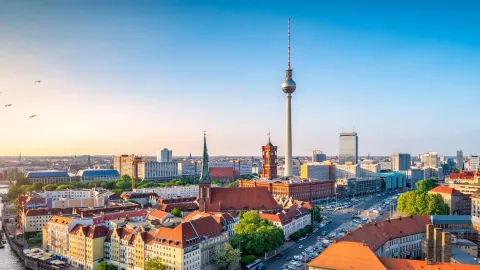

France
About the EURES Member
The population of France was 67.4 million inhabitants as at 1 January 2021. In 2020, the population increased by 0.2%. The natural population change, the difference between the number of births and deaths, decreased significantly due to the high increase in deaths related to the COVID-19 pandemic and the continuing drop in the number of births, amounting to +67 000.
Life expectancy at birth is 85.1 years for women and 79.1 years for men.
After 2020, which was characterised by an unprecedented crisis and a fall in recruitment, the economic stimulus plans enabled a strong recovery, with an increase in gross domestic product of 7.0% in 2021.
The unemployment rate at the end of the fourth quarter of 2021 was 7.4%, a decrease of 0.7 points compared to the previous year.
In 2021, 27 728 000 people were in work. The employment rate of the population aged 15 to 64 was 67.3%, the highest rate since 1975.
In 2021, employers reported 2.72 million planned recruitments. After an exceptionally high rate in 2020 (before the health crisis), the number of planned recruitments has therefore returned to a level that is slightly higher than it was in 2019 (+1.1%).
Depending on whether they are primarily seasonal jobs or not, and whether or not there are recruitment difficulties, the most in-demand occupations in 2021 fall into the three main groups shown below.
- The first group, which experiences great difficulties in recruiting workers and planned recruitments that are not closely linked to the season, includes personal care and support professions, in particular home helps and domestic cleaners (83 100 planned recruitments, an increase of 8.8% compared to 2019) and personal care workers (85 700 planned recruitments, an increase of 19.6%). Both of these professions present greater than average recruitment difficulties, which are particularly high for home helps and domestic cleaners (77.3%). A significant proportion of economically active young people (43%) are recruited as personal care workers. This figure is slightly lower for home helps (18%), as a higher proportion of people aged at least 50 (34%) are recruited for such positions. The first group also includes design executives and engineers, IT research and development, and project managers in the IT sector (44 400 planned recruitments, a decrease of 6.1% compared to 2019), among which there are virtually no seasonal planned recruitments and characteristically high expected recruitment difficulties (65.6%). Recruitment is primarily focused on young people (53% of recent recruits are economically active young people).
- The second group concerns non-seasonal occupations for which recruiters do not anticipate great recruitment difficulties. They include business services occupations, such as cleaners (113 900 planned recruitments, an increase of 1.0%) and security and surveillance officers (45 100 planned recruitments, an increase of 17.0%). More than a quarter of employees recently recruited as cleaners are at least 50 years old.
- The third group concerns professions for which employers anticipate few recruitment difficulties and a high reliance on seasonal staff: agricultural occupations, shelf-stackers, unskilled packaging and goods handling workers, social and cultural activity professionals, artists. As is the case every year, agricultural occupations are among the most in-demand jobs (149 100 planned recruitments for winegrowers, arboriculturists and crop pickers, an increase of 5.4% compared to 2019, and 88 200 planned recruitments for farmers and agricultural labourers, an increase of 17.6%).
Recruitment needs are growing for many occupations.This is the case for medical and paramedical professions, such as personal care workers (planned recruitments increased by 14 100 between 2019 and 2021) and nurses (an increase of 10 900 planned recruitments), as well as construction jobs, including unskilled manual workers for structural works (+8 000 planned recruitments) and finishing works (+7 700), builders (+5 200 planned recruitments), plumbers and heating engineers (+3 900 planned recruitments) and roofers (+900 planned recruitments).
Employers expected 1.85 million non-seasonal recruitments in 2021, an increase of 3.5% compared to 2019, that is 63 100 additional non-seasonal planned hires. In contrast, seasonal planned recruitments decreased by 3.6%.
In total, two thirds of planned hires are not seasonal (67.8% compared to 66.2% in 2019).
The occupations registering the highest numbers of non-seasonal planned recruitments include those related to maintenance, security, transport and logistics (cleaners, security officers, unskilled packaging and goods handling workers, lorry drivers), care and social support professions (home helps, auxiliary nurses, nurses), engineers, design executives and R&D staff in IT and trade occupations (shelf-stackers, serving staff, etc.).
Required skills
Almost half of all employers who were asked about the skills being increasingly listed under the recruitment criteria as a result of the health crisis mentioned observance of rules and procedures, with the highest figures in the accommodation and catering industries, as well as in administrative and support services (around 60%). 47% of establishments also mentioned the ability to organise one’s work and to work independently, with the latter mentioned in all sectors. Finally, 13% mentioned proficient use of digital tools and the ability to work remotely, with a naturally higher proportion for employers where teleworking is necessary for at least one employee (19%).
Unsuitable applicant profiles are mainly due to a lack of professional experience, motivation, technical skills or training.
Source: INSEE and BMO (labour needs) Survey 2021, Pôle Emploi
The health crisis, the restrictions and the economic consequences of these had a major impact on business activity in 2020. In the 2021 Labour Needs Survey, comparisons were mainly made with the results of the 2019 survey.
The number of planned recruitments by employers slightly increased between 2019 and 2021 (+1.1%), and represented 2.72 million potential new jobs.
This means 30 000 more planned recruitments recorded in 2021 compared to 2019.
This slight increase in planned recruitments is driven by the construction sector (21.7% increase between 2019 and 2021) and agriculture (+9.5%), while the number of planned recruitments dropped in industry (-7.0%) and in business services (-7.1%).
By contrast, recruitment difficulties rose in health occupations between 2019 and 2021.
Agricultural occupations are among the most in-demand professions (149 100 planned
recruitments for winegrowers, arboriculturists and crop pickers, and 88 200 for farmers and agricultural labourers). Most of these planned recruitments are seasonal.
Business services jobs also feature among the most in-demand jobs: cleaners (113 900 planned recruitments), unskilled packaging and goods handling workers (75 400 planned recruitments). The expected recruitment difficulties are lower than average for these jobs. Anticipated recruitment was high in care and social support professions, including home helps and domestic cleaners
(83 100 planned hires) and personal care workers (85 700 planned hires).
Source: BMO (labour needs) Survey 2021, Pôle Emploi
The 10 occupations signalling the least recruitment difficulties are:
- Artists (in music, dance, shows, art teachers) – 50 749;
- Cashiers – 32 038;
- Self-service store employees – 57 442;
- Various administrative officers (data entry, HR support, inquiries…) – 30 761;
- Wine producers, arboriculturists and crop pickers – 128 830;
- Reception and information staff, switchboard operators – 25 542;
- Salespersons for clothing, accessories and luxury items, sport, leisure and culture – 37 663;
- Unskilled manual workers in packaging and freight handling – 58 125;
- Office secretaries and similar occupations – 36 071;
- Cleaners – 105 388.
In 2020, 31% of establishments stated that they had attempted to recruit and 12% stopped recruiting following the health crisis, particularly establishments that had to cease activity for at least one month as a result of the health crisis. The most affected sectors were accommodation and catering services (22% of establishments stopped recruiting), audiovisual and communication services (19%), leisure activities, art and shows (16%), and transport and warehousing (16%), wholesale trade, finance and insurance activities and real estate.
Source: BMO (labour needs) Survey 2021, Pôle Emploi
Top 10 of the most required occupations in France
1. Commercial sales representatives (ISCO 3322)
2. Cooks (ISCO 5120)
3. Waiters (ISCO 5131)
4. Shop sales assistants (ISCO 5223)
5. Heavy truck and lorry drivers (ISCO 8332)
6. Accounting associate professionals (ISCO 3313)
7. Social work associate professionals (ISCO 3412)
8. Stock clerks (ISCO 4321)
9. Motor vehicle mechanics and repairers (ISCO 7231)
10. Mechanical engineering technicians (ISCO 3115)










